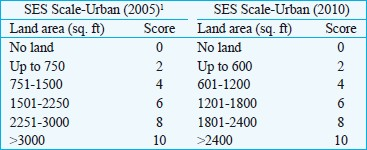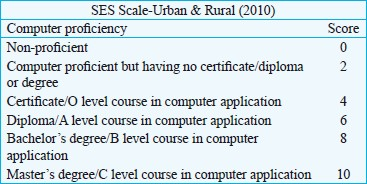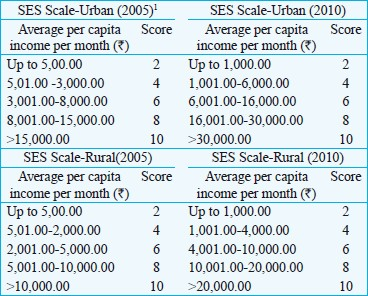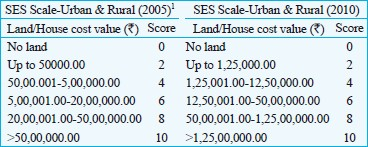Translate this page into:
Updation of the scale to measure socio-economic status in urban & rural communities in India
*For correspondence: sarvada1953@gmail.com
This is an open-access article distributed under the terms of the Creative Commons Attribution-Noncommercial-Share Alike 3.0 Unported, which permits unrestricted use, distribution, and reproduction in any medium, provided the original work is properly cited.
This article was originally published by Medknow Publications & Media Pvt Ltd and was migrated to Scientific Scholar after the change of Publisher.
Sir,
We have earlier developed a reliable and valid instrument for assessment of socio-economic status (SES) of households/individuals in urban as well as in rural areas of the country1. This scale1 has seven domains to assess socio-economic status namely House, Material possession, Education, Occupation, Monthly income, Land, and Social participation & Understanding. All seven profiles were equally weighted, each having a maximum score of 10. The score range (0-70) was categorized into five groups based on Central Government city compensatory allowance rules for each category of cities. The scale classifies the subjects into five types of SES categories i.e. Upper, Upper-middle, Middle, Lower-middle and Lower class. The scale was found to be highly reliable with a co-relation coefficient of 0.998 and the applicability of the scale was tested for its concurrent validity through field trial and was found to be of high degree.
In the last five years, this scale has been used on a total sample of 6935 subjects both from urban and rural areas in studies carried out in the Department of Geriatric Mental Health, C.S.M. Medical University, Lucknow, and was found to be an effective tool. Besides this, the scale is being used all across the country by various individual researchers/Institutes in their research activities/study programmes, etc2–10.
Over the past five years, there have been significant changes in the socio-economic matrix of the country, which necessitated modification and updation of the scale to make it use worthy. A provision for such updation every five years has been kept in the scale. The following updation is proposed with adequate rationale. There is no change in basic structure of the scale and thus the reliability and validity are not affected.
House profile
Land area: According to the Housing Policy, Govt. of Uttar Pradesh, 20 to 25 per cent land area has been decreased for the same category of house (LIG, MIG, etc.) in view of increasing population density and accommodating the maximum population in urban areas11. Considering this, the range of land area in SES scale-Urban has been decreased by 20 per cent. The land area and their respective scores mentioned in SES scale-Urban for 2005 and 2010 are given as under:-

In rural areas no change in land areas was found and, therefore, the range of land area in SES scale-Rural has been kept the same as earlier.
House type: In the updated scale, the house type (both in Urban & Rural) has been categorized only on the basis of type of roof, while in the 2005 version1, type of roof, walls and floor altogether were considered for the same. This change has been made according to the feedback received from various researchers who used this scale. They opined that many houses in their area did not fulfill all the three criteria and therefore, created confusion for giving score for such type of houses. For removing this discrepancy, the criteria for house type have been re-defined.

Material possession profile
Household gadgets: (i) The Consumer Price Index (CPI) value in India has increased by 56 per cent in the past five years12. The range for total value of household gadgets and their respective scores in SES scale 2010 (Urban & Rural both) has been modified as shown below:

(ii) The household item list has been updated in two ways- (a) The average cost of items in the household gadget list has been revised according to current market rate. (b) Some irrelevant items (Tape recorder, B/W TV, VCP, VCR, etc.) have been dropped and some more items (Digital Camera, Handy Cam, LCD-TV, etc.) have been included in the list.
Conveyance facility: The average cost of vehicles in the conveyance list has been updated according to current market rates while the range of total value of the vehicle possessed has been kept the same as earlier.
Education profile: In the present scenario, computer knowledge is an essential skill required in every work area and it has been included in school syllabus as well. As a result, one more section of computer proficiency has been added in this profile for both urban and rural areas. This profile has now two sub-sections (i) Educational qualification, and (ii) Computer proficiency.
The scoring in computer proficiency sub-section is on the same pattern as in the educational qualification. The categorization and their respective scores under this sub-section is provided as under:

Occupational profile: No change in this profile was made.
Economic profile
The per capita income of India13 is doubled in the last five years, hence per capita income range both in urban and rural areas has been increased in the same ratio as shown below:

Possessed land /house cost profile
From 2005 to 2010, the cost of land14 has increased by 100-300 per cent and house cost has increased by 80 per cent. Therefore, the average hike in land/house cost is 160 per cent. Considering this ratio, the range of land/house cost has been increased by 150 per cent.

Scoring & SES categories
Scoring pattern and SES categories remained the same as were in the original version while score range has been revised. In this updated SES scale, the score range has been classified in to three types according to the different categorization of the city based on Central Government HRA rules15.
Acknowledgment
The authors thank all the researchers and experts for their valuable feedback for updating this scale, and Prof. Mohd. Muzammil, Department of Economics, University of Lucknow and Shri Anil K. Pandey, Assistant General Manager, Uttar Pradesh Sahkari Gramin Vikas Bank, Lucknow, for valuable guidance. The assistance and co-operation provided by all the staff members of d0 epartment of Geriatric Mental Health, C.S.M. Medical University, Lucknow is duly acknowledged.
References
- Development & standardization of a scale to measure socio-economic status in urban & rural communities in India. Indian J Med Res. 2005;122:309-14.
- [Google Scholar]
- Psychosocial characteristics as perceived by families in north Indian community. Delhi Psychiatry J. 2010;13:306-13.
- [Google Scholar]
- Air pollution and its impact on lung function of children in Delhi, the capital city of India. Water Air Soil Pollut. 2010;212:89-100.
- [Google Scholar]
- Sociodemographic comparison and impact of aila: The supercyclone in Gosaba of West Bengal. Indian J Community Med. 2010;35:429-32.
- [Google Scholar]
- Effect of a amitriptyline vs. physiotherapy in management of fibromyalgia syndrome: What predicts a clinical benefit? J Postgrad Med. 2009;55:185-9.
- [Google Scholar]
- Socio-economic status as a determinants of needs of rural elderly. Indian J Geriatric Mental Health. 2008;4:27-34.
- [Google Scholar]
- Usefullness, acceptability and benefits of behavioural interventions programme: A community response. Psychological Stud. 2007;52:240-3.
- [Google Scholar]
- Health effects of chronic exposure to smoke from biomass fuel burning in rural areas. 2007. Final Report. Available from: www.whoindia.org/ LinkFiles/Environmental_Epidemiology_biomass_fuel_in_rural_areas.pdf
- [Google Scholar]
- The effects of the 2008 Equestrian Olympic Games on the development of Equestrian in Hong Kong 2007; This is an Honours project submitted for the Degree of B.A. in Physical Education and Recreation Management. Available from: http://libproject.hkbu.edu.hk/trsimage/hp/05007356.pdf.
- [Google Scholar]
- Delhi Children Final Report. Available from: www.whoindia/LinkFiles/ Environmental_Epidemiology_air_poll__rural_child_ref.pdf
- [Google Scholar]
- Notification no. 5136/8-3-2008-11 Miscellaneous/08, dated 25-09-08, Housing and Urban Planning section-3, Govt. of Uttar Pradesh.
- [Google Scholar]
- Inflation India-Consumer price index (CPI) Available from: http://www.global-rates.com
- [Google Scholar]
- Swamy's hand book 2011. Chennai: Swamy Publishers (P) Ltd; 2011.





